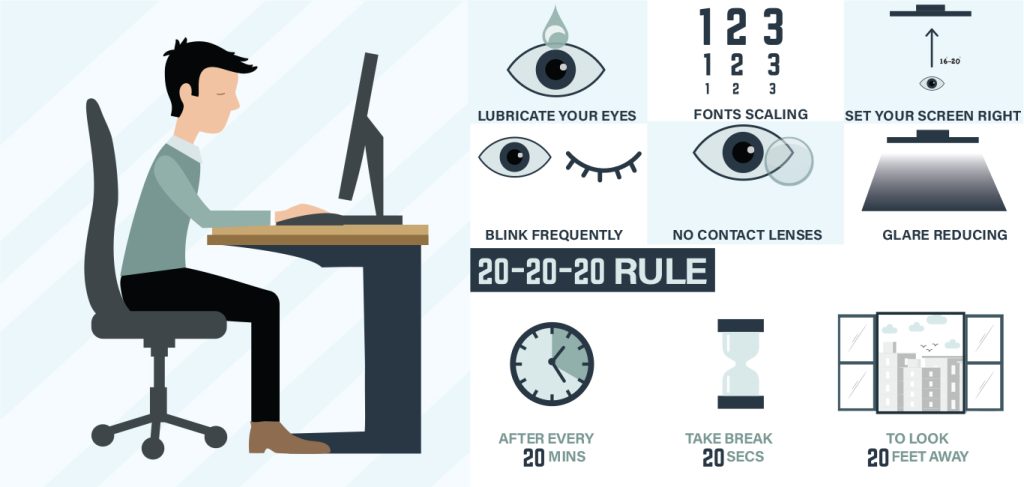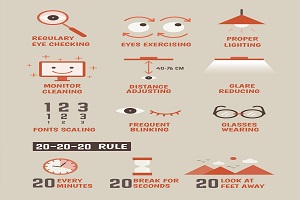In our screen-dominated world, eye strain has become a common complaint for many people. Whether you’re working on a computer, scrolling through your smartphone, or binge-watching your favorite series, your eyes are constantly at work. To combat this, many have turned to the 20-20-20 rule. But does this rule really prevent eye strain? In this article, we’ll dive into what the 20-20-20 rule is, how it can help, and other effective strategies for maintaining eye health.
What Is the 20-20-20 Rule?
Understanding the Rule
The 20-20-20 rule is a simple guideline aimed at reducing digital eye strain. According to this rule, every 20 minutes, you should take a break and look at something 20 feet away for at least 20 seconds. This practice encourages your eyes to refocus, reducing fatigue and discomfort associated with prolonged screen time.
The Origin of the Rule
The 20-20-20 rule gained popularity as more people began using digital devices for extended periods. Eye care professionals noticed an increase in cases of digital eye strain, leading to the recommendation of this simple technique as a preventive measure.
Why Do We Experience Eye Strain?
Understanding Eye Strain
Eye strain, also known as asthenopia, occurs when your eyes become fatigued from intense use. Symptoms can include:
- Blurred or double vision
- Dry or watery eyes
- Headaches
- Difficulty focusing
- Burning or itching sensations
Common Causes of Eye Strain
Several factors contribute to eye strain, especially in our digital age:
- Prolonged Screen Time: Staring at screens for long periods without breaks can tire the eye muscles.
- Poor Lighting: Insufficient or harsh lighting can make it harder for your eyes to focus.
- Improper Posture: Sitting too close to your screen or in an awkward position can lead to additional strain.
- Uncorrected Vision Problems: Undiagnosed or uncorrected vision issues, such as nearsightedness or astigmatism, can exacerbate eye strain.

How Does the 20-20-20 Rule Help?
Refocusing Your Eyes
When you follow the 20-20-20 rule, you give your eye muscles a chance to relax. Focusing on something farther away helps to reduce the continuous strain caused by staring at a close-up screen. This act of refocusing is crucial for maintaining comfort.
Reducing Dryness and Irritation
Looking at screens can reduce your blink rate, leading to dry and irritated eyes. Taking regular breaks to look away encourages more frequent blinking, which helps to moisten and refresh the eyes.
Psychological Benefits
Taking a break every 20 minutes allows you to reset your focus not just physically, but also mentally. Stepping away from your screen can relieve tension and improve your overall concentration and productivity.
Implementing the 20-20-20 Rule Effectively
Setting a Timer
To ensure you’re following the 20-20-20 rule, consider setting a timer on your phone or computer. This reminder will help you develop the habit of taking breaks.
Making It a Routine
Incorporate the 20-20-20 rule into your daily routine. For example, if you work at a computer for several hours, use the rule consistently to help reduce eye strain.
Combine with Other Eye Care Practices
While the 20-20-20 rule is effective, it’s best combined with other eye care strategies for maximum benefit.

Other Strategies to Prevent Eye Strain
1. Adjust Your Workspace
Creating an ergonomic workspace can make a significant difference in reducing eye strain:
- Monitor Position: Keep your computer screen about an arm’s length away and positioned slightly below eye level.
- Lighting: Ensure your workspace is well-lit to reduce glare. Use desk lamps with adjustable brightness if necessary.
- Reduce Glare: Consider using anti-glare screen protectors on your devices to minimize reflections.
2. Practice the 20-20-20-20 Rule
This extended version involves an additional step. After your 20-second break, try doing the following:
- Look up and around: After focusing on a distant object for 20 seconds, spend another 20 seconds looking around your environment. This helps to relax your eye muscles further.
3. Blink Regularly
Consciously remind yourself to blink more often. This helps keep your eyes moist and reduces dryness. You can set reminders or simply make it a part of your routine.
4. Use Eye Drops
If you frequently experience dryness, consider using artificial tears or lubricating eye drops. These can help keep your eyes moist and comfortable, especially during extended screen time.
5. Stay Hydrated
Drinking plenty of water is crucial for overall health, including eye health. Staying hydrated can help maintain tear production and reduce dryness.

When to See a Doctor
Persistent Symptoms
If you experience frequent or severe eye strain despite following the 20-20-20 rule and other preventive measures, it’s important to consult an eye care professional. Symptoms that warrant a visit include:
- Persistent headaches
- Ongoing blurry vision
- Difficulty focusing
- Pain in or around the eyes
Regular Eye Exams
Routine eye exams are essential for maintaining eye health. During these visits, your eye doctor can check for any underlying vision problems and recommend appropriate corrective measures, such as glasses or contact lenses.
Conclusion
The 20-20-20 rule is a simple yet effective strategy for reducing eye strain in our increasingly digital world. By taking regular breaks to refocus your eyes, you can alleviate discomfort and promote better eye health. However, it’s essential to combine this practice with other eye care strategies, such as adjusting your workspace and maintaining proper hydration.
If you experience persistent symptoms or discomfort, don’t hesitate to seek professional advice. By being proactive about your eye health today, you can ensure clearer vision and greater comfort for years to come.
